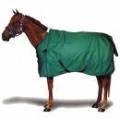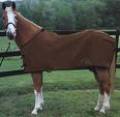
Horse Blankets Reviews
|
Equine Dermatophilosis
Equine Dermatophilosis
Dermatophilosis is a condition that horses can contract. Dermatophilosis is a condition commonly referred to as rain rot, rain scald, and streptothricosis. Dermatophilosis that appears on the horses lower leg is often called dew poisoning. Although Dermatophilosis can be seen throughout the country it is most common in the southeastern portion of the United States where the weather condition is frequently wet, warm, and humid.
Dermatophilosis is most commonly seen in horses mammals such as cattle, sheep, and goats are also commonly affected. Dermatophilosis has also been diagnosed in pigs, dogs, and cats although the condition is not as common. A few rare cases of humans being affected with Dermatophilosis have also been diagnosed.
The younger the horse the more likely it is to contractDermatophilosis.
Horse owners that have dealt with cases of Dermatophilosis say that their horses had scabs or hive like bumps on that measured approximately one fourth of an inch across, these hives are typically easy to peel or rub off. Although these lesion were most commonly seen covering the horses haunch area it is not uncommon to see the horse's entire body
affected by Dermatophilosis.
Many horse owners assume that the rain rot is caused by a fungus. Dermatophilus congolensis is interesting because it shares charastics with both fungus's and bacterias. They are wrong. Dermatophilosis is in fact caused by an organism called dermatophilus congolensis. In horses the dermatophilus congolensis works by entering the follicle of the horses hair
shaft. Once it is in the horses hair shaft it can be seen in the form of a large hive. When these hives are removed from the skin horse owners can easily see several (literally dozens and dozens) of hairs embedded in each large lump. Because the dermatophilus congolensis damages the hair root removing these hives does not seem to bother or pain the horse in
anyway. Once the scabs/hives are removed owners can see that the skin under the hives is generally a pink color and oozing a yellow pus.
Horses affected by Dermatophilosis do not seem to be in pain nor do they appear to be embarrassed by their condition. The only time the condition appears to be painful is if the area affected is a covered with a saddle. Owners who have a horse who has signs of Dermatophilosis on their spine should refrain from riding until the condition has cleared.
Typically veterinarians do not recommend using any ointments to treat Dermatophilosis because the ointments simply add moisture to the affected areas of skin. One old time method for treating Dermatophilosis is swapping the affected are with used motor oil (for some reason fresh motor oil does not treat the affected area). Most owners like to bath their
horses with antibacterial shampoos.
Dermatophilosis is contagious. If you have a horse that has been affected try to separated it from its pasture mates. Make sure that you keep its grooming supplies separated from other horses. Do not use leg wraps, saddle blankets, splint boots, and halters on any other horses. If you have to use equipment on other horses make sure you completely disinfect all the equipment before it touches the hide of another horse. Keeping equipment such as leg wraps and blankets dry will help prevent a second outbreak of Dermatophilosis.
Because the skin that has been affected with Dermatophilosis is hairless it is prone to sunburn. Rather then swap the bald patches with sunscreen which adds moisture to the skin horse owners that keep their horses outside should use a fly sheet to protect their horse from UV rays. The blanket should be washed on a regular basis to kill the dermatophilus
congolensis.
 |
 |
 |
About Horse Saddles And Horse Blankets
Do You Show Your Horse Love In The Winter
A Peek Into The History Of Horse Blankets
Are Horse Blankets Really Necessary
The Different Types Of Fly Sheets
The Various Types Of Horse And Blankets And Sheets
More Horse Blankets Articles
When Do You Need Horse Equipment
... of becoming a mental security blanket, the horse blanket has several more important uses, and you may even want to purchase one for yourself. When you choose your horse equipment, or even your horse blanket, seek the aid of an experienced horseman. You may want advice from both someone who is new to the ...
... actually considered ponies just because of their size. Ponies are 14 hands high, compared to the 8 hand size of a mini. But the baby minis are called ponies until they are grown, just as other horse babies. You shouldn't need as much horse tack for these mini horses because they are not used in the same ...
Do You Show Your Horse Love In The Winter
... particulars of his care. A cold horse in winter is a pitiful thing indeed. If you decide to buy a horse, even if it is just for the sake of saying you own one, please take the time to provide proper care and housing, medical attention, and the right equipment. Part of that equipment and proper care involves ...
The Different Types Of Fly Sheets
... mesh material that is easy to clean. In the event of severe stains (manure and grass are the most common) blanket owners can try using a stiff, sudsy brush directly on the stain. this works especially well if the blanket is laid on a concrete surface. A fly sheet made with polyvinyl will typically dry ...

|
| Copyright © 2006-2012 Internet Marketing Tools, All Rights Reserved |